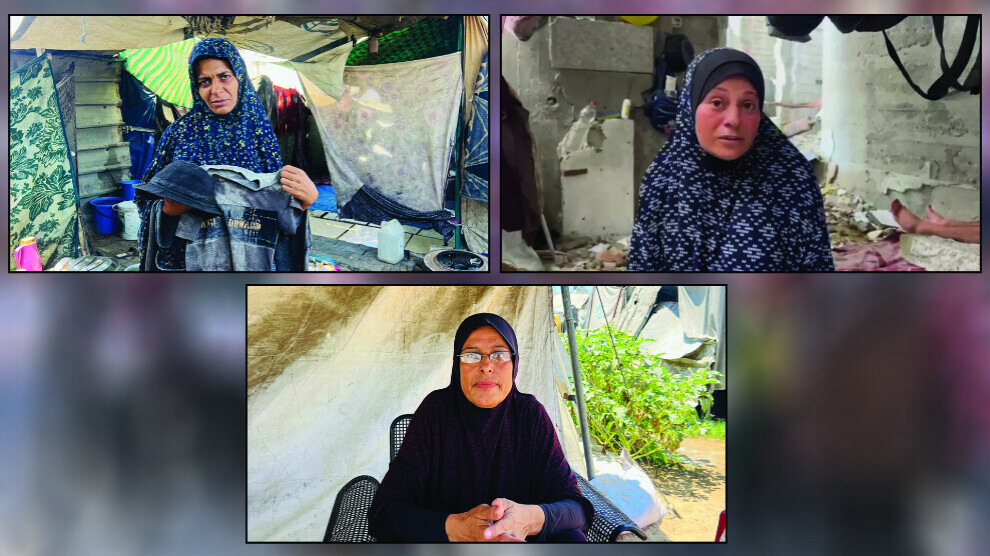Famine in Gaza: Pain beyond bombardment
Hunger is ravaging the bodies of children and women in Gaza, exposing another face of war—one more devastating than airstrikes and destruction.

NAGHAM KARAJEH
Gaza — In the besieged enclave, it is no longer bombardment alone that kills; starvation has become a deadlier weapon, striking children and women before shrapnel reaches them. Since October 7, 2023, the humanitarian crisis has deepened on multiple fronts: relentless bombardment targeting neighborhoods, a suffocating siege choking cities, and famine uprooting lives. Within this overwhelming tragedy, mothers’ stories emerge as stark mirrors of loss and helplessness—each carrying a wound that will not heal and a cry that finds no echo.
Killed for a loaf of bread
Noura al-Lahham, displaced from Beit Lahia to Gaza City, bears witness to a cruelty she says she has never known. Fighting back tears, she recounts:
“I was forced to watch my five children starve. I tried to find what I could in the markets, but everything was beyond my reach. My son Ahmed, 14, could not endure it any longer. He thought the only solution was to go to the Zikim area, where some aid passes through. I knew it was dangerous—a death trap. I begged him not to go, but he insisted, for our sake. He went and never came back. He was carried back to me on shoulders, his clothes drenched in blood, his body already frail from malnutrition before bullets ended his life. How do I accept that my child died for a loaf of bread? How do I live with the knowledge that famine killed my son?”
Loss is not new to Noura. She lost her poultry farm in 2014, then tried to rebuild with her husband by selling small handicrafts, only to see the war crush everything again. Today she lives in a worn-out tent with no flour to her name, holding onto her son’s blood-stained cap and shirt. “Every night I place the cap under my pillow and feel like he will come back, though I saw him dead,” she says. “My only dream now is that my other children don’t die of hunger as he did.”
Statistics paint an even grimmer picture. UNICEF and the World Health Organization report that more than half a million people in Gaza are enduring famine-like conditions, while the rest of the population faces varying levels of acute hunger. UN data released in early 2024 showed one in six children under two suffering severe malnutrition, with more than 200 deaths—over half of them children—already linked to hunger and malnutrition since the war began.
Fear children may return dead
For Yasmeen Saleha, hunger is more brutal than bombardment. “We are all hungry in Gaza, no exceptions,” she says bitterly. “I thought more than once of going myself to aid points, but I’m too old and my body cannot handle the effort. I absolutely refused to send my children—I was terrified they would be killed. How can a mother bear to see a loaf of bread soaked in her child’s blood? If that happened, I would see that image every time I looked at bread for the rest of my life.”
She recalls how Gazans, once known for generosity and abundance, are now left searching through ruins for food. “We were known for hospitality; we never turned away a guest or someone in need. Today we are the needy. I’ve seen women putting anise water in baby bottles instead of milk. Children scream from hunger, and the only way to quiet them is with boiled water and herbs. What cruelty makes a mother unable to give her baby even a drop of milk?”
In July 2025, Save the Children reported that 43% of pregnant and breastfeeding women in Gaza suffer from severe malnutrition threatening their lives and their babies. Doctors Without Borders has documented that a quarter of infants under one year suffer acute wasting, while nearly one-fifth of pregnant or nursing women face the same condition. With flour prices tripling and daily rations cut to a single meal for most families, hunger in Gaza is no longer a byproduct of war—it has become a weapon.
Children ravaged by hunger
Tahani Awad, in her thirties, faces another torment with her children. Holding back tears, she says:
“Sometimes I wish for a piece of candy, not for myself but for my children. When they ask for something as simple as bread, I feel like the ground is swallowing me. How can a mother hear her child say, ‘I’m hungry,’ and have nothing to give? I feel powerless, like a mother of no worth.”
She describes the market as a scene of cruel disparity. “When goods do come in, the prices are unbearable. I stand in front of food as if it has a sign saying, ‘This is not for you.’ Imagine a loaf of bread becoming a luxury. How long must we live between bombardment, hunger, and death? What crime have we committed to deserve starvation?”
Weaponised hunger
The gravest reality is that hunger is no longer a side effect of war but a deliberate weapon. When food and medicine are blocked, when flour prices rise 300%, when infant formula is denied entry, the equation is clear. This is a war not only against fighters but against mothers and newborns.
In Gaza, mothers mourn not just demolished homes but children who died asking for food. Noura lost her son Ahmed; Yasmeen fears losing hers for a piece of bread; Tahani breaks under the hunger of her children. Behind these voices stand half a million people on the edge of famine, pregnant women collapsing from weakness, and toddlers whose bodies shrink to skin and bone.
Hunger in Gaza is a slow weapon designed to subjugate an entire people. While the world counts the dead from airstrikes, other victims are buried silently—in the graves of hunger.
